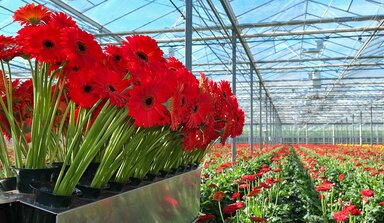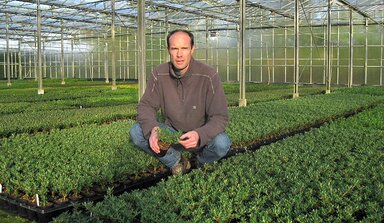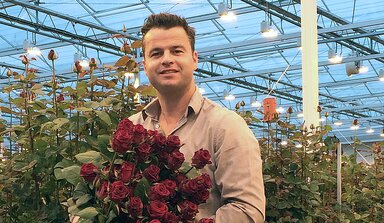Grower harvests more freesia stems under ReduFlex Blue
Following a number of trials with various coatings, Tesselaar Freesia opted for ReduFlex Blue. This coating reflects heat and partially shields blue light. The result: better growth with more harvestable stems per square metre.
Tesselaar Freesia in Heerhugowaard, the Netherlands, is a unique company constantly in search of innovative solutions. Together with their colleagues at Mol Freesia they regularly appear in the news because they are making use of a revolutionary solar thermal installation. Using large solar panels (see photo) they capture the sun’s heat, which is stored in the ground after which it is used when needed. This way they manage to grow their crops without the need for natural gas.
Furthermore, a great deal of thought has gone into controlling the greenhouse climate. Multiple screens, several Nivolators (a ventilator that helps create a uniform greenhouse climate) and misting systems are used.
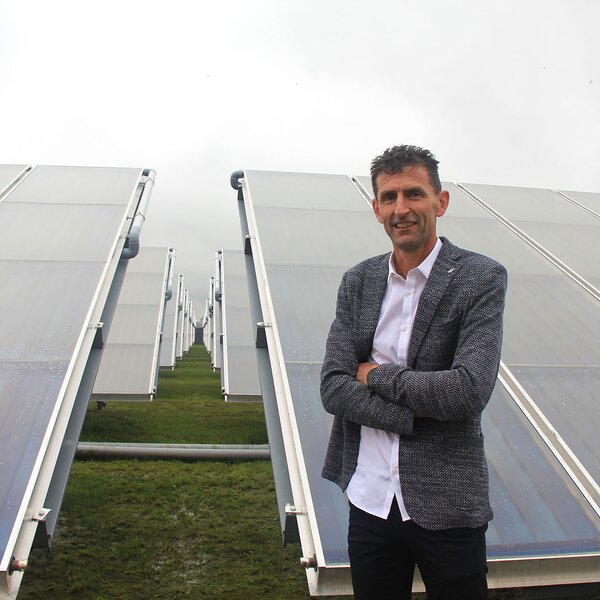
It is this innovative installation that resulted in the choice of ReduFlex Blue.
“The most common coating used for freesias is ReduSol. However, we conducted a number of trials with various coatings to determine the best choice for us. We compared ReduSol with ReduFuse IR and ReduFlex Blue. The conclusion was that the latter proved to yield the best result,” says owner Pip Tesselaar.
Keeping the heat outside the greenhouse
The company has 3.7 hectares for cultivating flowers and one hectare for propagating planting material. The crop is sold in cooperation with 11 colleague growers as part of the Unicum Freesia growers association.
In the past, freesia growers did not chalk or coat their greenhouses. Instead, heat peaks were blocked using movable screens. Tesselaar: “However, today we have gained better insights. Freesias do not like heat and when you close the screen, the heat is already inside the greenhouse. It is therefore better to do something on the outside of the greenhouse to prevent the heat from entering in the first place. Coating has since become a fairly common practice and virtually all of our colleagues use ReduSol.”
However, Tesselaar was looking for options that would allow more PAR light to enter the greenhouse, while reflecting heat radiation. “When you apply a layer of ReduFlex Blue in the same thickness as ReduSol – for example, 18 buckets – it will allow more light into the greenhouse. This improves growth somewhat and the stems are longer,” he says.
Stem growth
ReduFlex Blue is a coating that selectively allows the colours of the light spectrum to enter or selectively blocks them. The coating reduces the amount of blue light entering the greenhouse. In general, this increases the crop’s stem-length somewhat. Outside the PAR region, the coating reflects UV, as well as infrared. The latter is also referred to as heat radiation. ReduFlex Blue has a considerable reflective effect, which is a major benefit for a crop such as freesia, which does not like heat.
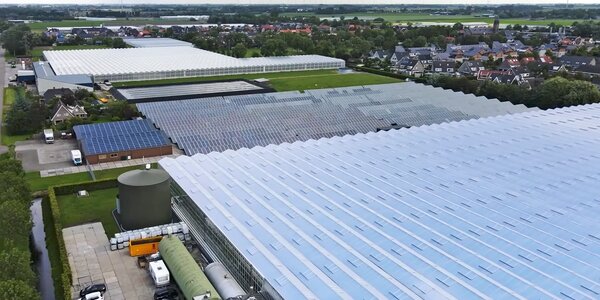
Pip Tesselaar
Tesselaar sees that his choice has a clear effect on production. “Freesias normally produce about five side stems or shoots. The first one is always cut with the main flower. The position of the second spike is important. If it is at 47 cm, it must be cut because the standard stem length is 50 cm. However, if it is positioned at 55 cm, it can be left. It will then continue to grow and can later be harvested for sale to the retail sector. We are seeing increased stem length under ReduFlex Blue and therefore an increase in the stems that can be harvested.”
Today he only uses the movable screen in extreme situations or immediately after planting. It is then important to keep the soil temperature under control. “When the greenhouse and soil temperatures become too high this is at the expense of shoot formation. The plant will then only have one to two side branches, even when misting is applied. Therefore: It is very important to keep the heat out of the greenhouse as much as possible.”
